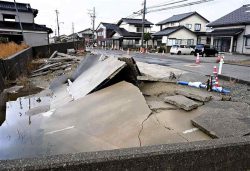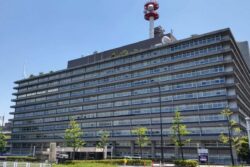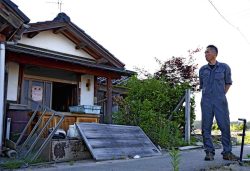Few Residents’ Associations Set Up in Disaster-Hit Towns; Delays Can Hinder Care for Elderly Residents
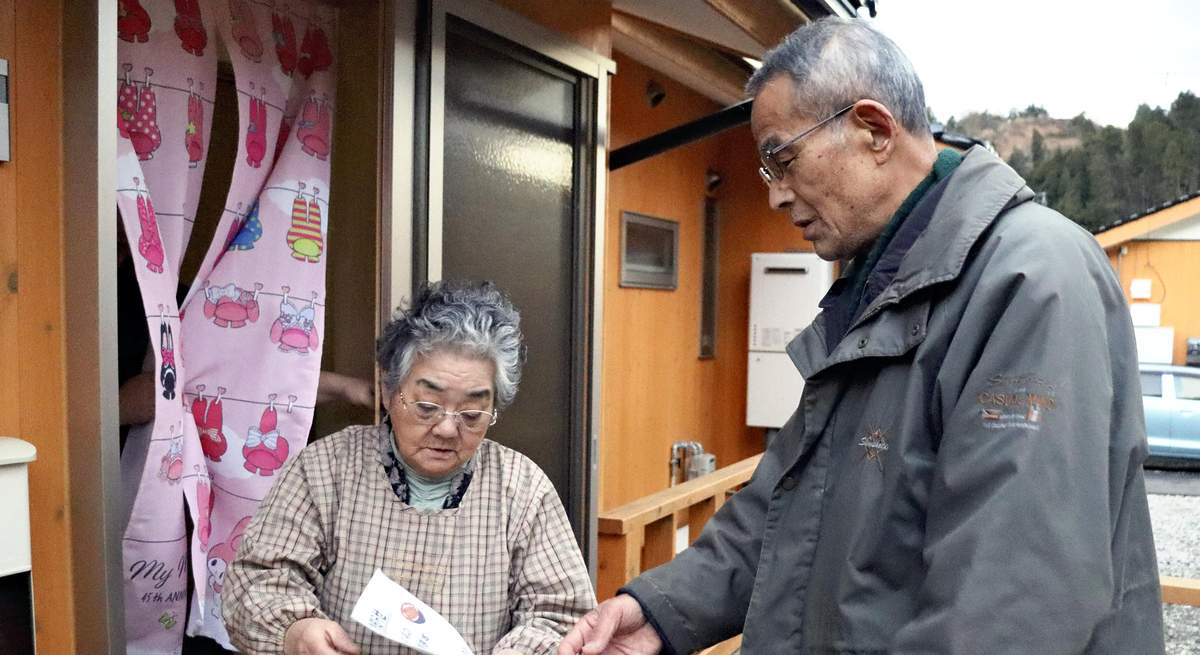
A male resident checks up on his neighbors and gives a handout to a woman living in the same temporary housing complex in Wajima, Ishikawa Prefecture, on Dec. 19.
21:00 JST, December 31, 2024
KANAZAWA — As Wednesday marks one year since the Noto Peninsula Earthquake in Ishikawa Prefecture, few residents’ associations have been established at temporary housing complexes in the cities of Suzu and Wajima, both in the prefecture. Both areas were severely affected by the earthquake on Jan. 1, 2024, and record rainfall in September.
Fewer than 10% of all such complexes in Suzu have set up residents’ associations that have already decided their representatives or rules, while only 30% have done so in Wajima. Delays in establishing such groups might affect self-help activities among residents, such as preparing for disasters, clearing snow and watching over elderly residents.
“I’m worried about whether anyone will tell me to evacuate when a disaster occurs,” an 86-year-old woman lamented. She has been living alone since April in a temporary housing complex more than three kilometers away from her house, which was destroyed in the earthquake, in Suzu.
The housing complex accommodates disaster-affected people from various districts. There is no residents’ association, and residents do not see each other very often because many of them are away during the day to clean up their homes or work.
In the heavy rainfall in September, the water level reached beyond the slope at the entrance of the housing complex and many residents evacuated to the field behind the complex. The woman was not aware of the abnormal situation until she looked out the window and hastily evacuated.
The building was not flooded, but she wanted to interact with other residents. “I want to be connected to my neighbors,” she said.
Residents’ associations help deepen friendships within the community, make rules for taking out the trash and clearing snow, and engage in anti-crime activities. To that end, the Ishikawa prefectural government created a subsidy program to provide up to ¥200,000 for each housing complex to help establish residents’ associations. It also held a meeting of officials from municipal governments at the end of September and asked the participants to promote the establishment of residents’ associations.
Subhead: Difference from other municipalities
The Yomiuri Shimbun gathered information on residents’ associations at a total of 120 temporary housing complexes in four municipalities in the Okunoto region of the prefecture — Suzu, Wajima, Noto and Anamizu — and found that almost all temporary housing complexes in the towns of Noto and Anamizu had their own residents’ associations as of Dec. 27. However, only four out of 45 housing complexes in Suzu and 16 out of 46 in Wajima had such groups as of the same date.
According to the Health, Labor and Welfare Ministry, 70% of the temporary housing complexes in the three prefectures of Iwate, Miyagi and Fukushima that were affected by the 2011 Great East Japan Earthquake had residents’ associations a year after the disaster. Compared to these municipalities, the slow establishment of residents’ associations in Suzu and Wajima stands out.
The two cities suffered serious damage from the earthquake and rainfall. People affected by these disasters have made such comments as “I’m busy cleaning up my house” and “I struggle because I don’t know most of my neighbors in the temporary housing complex.”
The construction of some temporary housing complexes has been delayed, and people who had finally moved into other facilities were forced to temporarily leave their units due to flooding.
“People from multiple districts across broad areas live in temporary housing complexes, so these complexes face unique difficulties,” an official at the Wajima municipal government said. “Many of the residents are elderly and there are only a few people who are willing to be representatives of residents’ associations.”
"Society" POPULAR ARTICLE
-

M4.9 Earthquake Hits Tokyo, Neighboring Prefectures
-

Israeli Tourists Refused Accommodation at Hotel in Japan’s Nagano Pref., Prompting Protest by Israeli Embassy and Probe by Prefecture
-

M7.5 Earthquake Hits Northern Japan; Tsunami Waves Observed in Hokkaido, Aomori and Iwate Prefectures
-

Tsukiji Market Urges Tourists to Avoid Visiting in Year-End
-
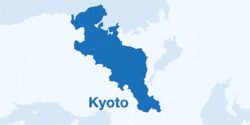
High School in Kyoto Says Students Shoplifted during Recent School Trip to Bali, Indonesia
JN ACCESS RANKING
-

Tokyo Economic Security Forum to Hold Inaugural Meeting Amid Tense Global Environment
-

Keidanren Chairman Yoshinobu Tsutsui Visits Kashiwazaki-Kariwa Nuclear Power Plant; Inspects New Emergency Safety System
-

Imports of Rare Earths from China Facing Delays, May Be Caused by Deterioration of Japan-China Relations
-

University of Tokyo Professor Discusses Japanese Economic Security in Interview Ahead of Forum
-

Japan Pulls out of Vietnam Nuclear Project, Complicating Hanoi’s Power Plans


